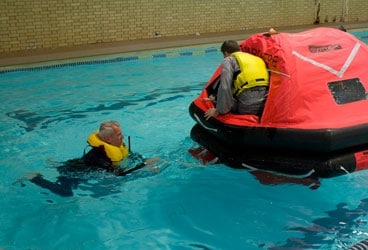
liferaft practice 368
It was a beautiful, blustery summer afternoon, and we were barreling along under just the main, reaching comfortably toward our evening’s anchorage. My wife, Sue, was lolling on deck, and my young daughter and a friend were playing below. Alone in the cockpit, I heard a zing and saw the monofilament start to peel off the reel of the rod in a holder on the aft pulpit.
“Fish on!” I joked, expecting I’d snagged the usual seaweed. But then I saw a fish jump.
Sue took the wheel and luffed us up to slow down as I reeled it in. It wasn’t a monster, and I had no trouble pulling the flopping little fellow into the cockpit. He’d hooked himself by the jaw on one barb of the lure’s two treble hooks, and I was about to set him free when a wave knocked the side of the boat. Next thing I knew, the fish had slipped from my grip and I had one hook dug well into the meat of my left thumb, another stuck in my little finger. And, of course, the fish was still hooked.
I quickly grabbed the bastard and told Sue to get a knife. In her hurry to free the fish, she managed instead to slice open the back of one finger. My blood, her blood, and fish blood seemed to be everywhere, as two very scared kids stared up at us from the companionway.
“I’m going to call the Coast Guard,” my daughter threatened. “Oh, just what we need,” I thought as I calmed everyone down. With some paper towel wrapped around her finger, Sue managed to cut the fish’s lip and free it so I could toss the devil incarnate overboard. I then turned my attention to removing the two hooks from my fingers, fully intending to self-medicate and sterilize with Mount Gay, ASAP.
It was astonishing how quickly things had turned south, I reflected later, the boat now safely tied to a mooring and my thumb throbbing as I continued my self-administered doses of painkillers cut with O.J. You’ve no doubt been there, too, caught up in that moment when all’s well turns to pure hell. I remember the evening we were sailing along just fine one minute, and the next were staring with disbelief at pulled-out chainplates. Or that day when a stuck ignition switch caused the starter and nearly the whole engine compartment to catch fire. The kids learned new salty terms that day.
Yes, I fall squarely into the camp of those who wince in anticipation when someone on board mentions how perfect the sail is. My wood coamings, in fact, have wear marks from me knocking on them. But it turns out I’m not the only one who braces for the worst of times while enjoying the best. Last spring, my job took me to Safety-at-Sea seminars in Newport, Rhode Island, and Annapolis, Maryland, where I met lots of other sailors who want to be ready for what the Sea Sirens have in store. These seminars lay a foundation for action, as do CW’s annual Safety-at-Sea issues and the many good books on the subject.
The longtime S.A.S. instructor and expert John Bonds opened the Newport session by saying, “We think about what could happen, so when it does happen, we’ve thought it through.”
In the end, good ol’ Murphy is crew on all our boats. Will you be ready when he comes on watch and decides to take the helm?
Mark Pillsbury








